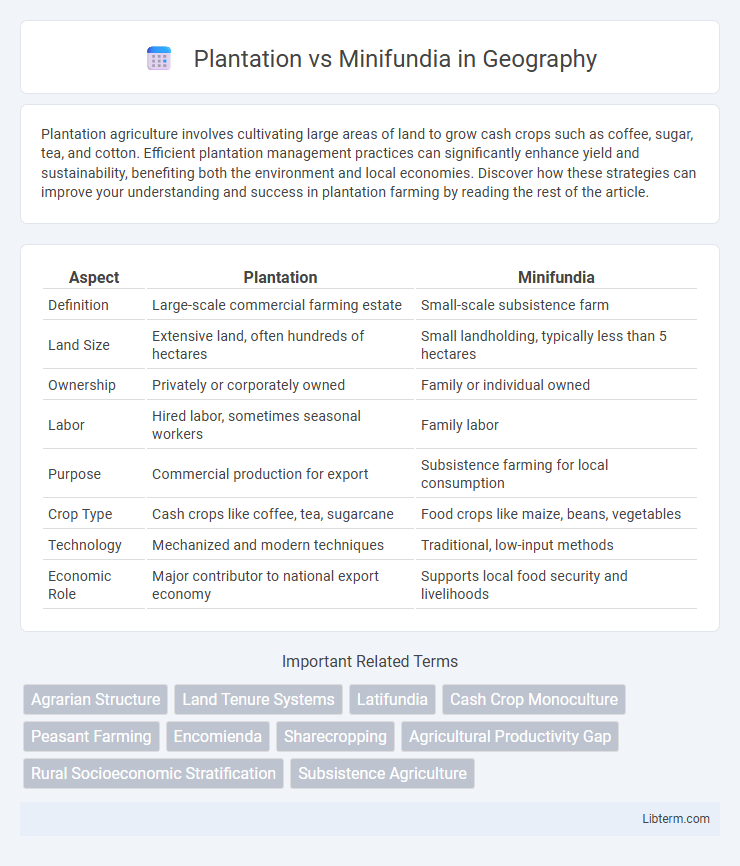Plantation agriculture involves cultivating large areas of land to grow cash crops such as coffee, sugar, tea, and cotton. Efficient plantation management practices can significantly enhance yield and sustainability, benefiting both the environment and local economies. Discover how these strategies can improve your understanding and success in plantation farming by reading the rest of the article.
Table of Comparison
| Aspect | Plantation | Minifundia |
|---|---|---|
| Definition | Large-scale commercial farming estate | Small-scale subsistence farm |
| Land Size | Extensive land, often hundreds of hectares | Small landholding, typically less than 5 hectares |
| Ownership | Privately or corporately owned | Family or individual owned |
| Labor | Hired labor, sometimes seasonal workers | Family labor |
| Purpose | Commercial production for export | Subsistence farming for local consumption |
| Crop Type | Cash crops like coffee, tea, sugarcane | Food crops like maize, beans, vegetables |
| Technology | Mechanized and modern techniques | Traditional, low-input methods |
| Economic Role | Major contributor to national export economy | Supports local food security and livelihoods |
Introduction to Plantation and Minifundia Systems
Plantation systems consist of large-scale agricultural estates primarily focused on producing cash crops such as coffee, tea, rubber, and sugarcane for export markets. Minifundia refers to smallholder farms characterized by fragmented landholdings, often less than two hectares, where subsistence farming dominates, producing diverse crops mainly for local consumption. These two systems contrast in scale, purpose, and economic impact, with plantations emphasizing commercial agriculture and minifundia supporting rural livelihoods.
Historical Background and Origins
Plantations originated during the colonial era as large-scale agricultural estates designed for cash crop production, often relying on enslaved or indentured labor to maximize output for export markets. Minifundia, in contrast, emerged in Latin America as small, family-owned plots resulting from land reforms and the fragmentation of large estates after colonial rule. The historical division stems from economic and social structures: plantations reflect colonial export-oriented economies while minifundia represent subsistence farming shaped by indigenous and peasant traditions.
Key Characteristics of Plantation Agriculture
Plantation agriculture is characterized by large-scale commercial farming focused on monoculture crops such as sugarcane, tea, coffee, and rubber, primarily for export markets. It typically involves the use of advanced machinery, hired labor, and capital-intensive practices, contrasting with the small-scale, subsistence-oriented minifundia that rely on family labor. Plantations are usually located in tropical climates with fertile soils and benefit from organized infrastructure to support large production volumes.
Defining Features of Minifundia Farming
Minifundia farming is characterized by small-scale agricultural plots typically managed by family labor, focusing on diverse subsistence crops to sustain household needs. Unlike extensive plantation systems that prioritize monoculture for commercial export, minifundia farms emphasize crop diversity, soil conservation, and traditional farming techniques. These farms often face limitations in mechanization and capital investment but contribute significantly to food security in rural regions of Latin America and developing countries.
Geographic Distribution and Global Patterns
Plantations dominate in tropical regions such as Southeast Asia, Central and South America, and parts of Africa due to favorable climate and market demand for commodities like rubber, oil palm, and coffee. Minifundia are prevalent in mountainous and less fertile areas of developing countries, particularly in Latin America and parts of Asia, where smallholder subsistence farming sustains local communities. Global patterns reveal plantations as large-scale, export-oriented agricultural enterprises concentrated near ports and infrastructure, while minifundia reflect fragmented landholdings with low mechanization linked to traditional subsistence economies.
Economic Impacts and Productivity
Plantations generate higher economic output through large-scale, mechanized production that benefits from economies of scale, leading to increased productivity and export earnings. Minifundia, characterized by small, family-run farms, often produce subsistence crops with limited surplus, resulting in lower economic impact but greater local food security. While plantations drive industrial agriculture growth and foreign investment, minifundia contribute to rural employment and sustainable livelihoods despite lower productivity.
Social and Labor Dynamics
Plantations typically employ large-scale, wage labor systems with hierarchical management, often resulting in limited worker autonomy and seasonal employment instability. Minifundia, characterized by small-scale, family-owned farms, rely heavily on family labor and foster stronger communal ties, promoting subsistence and local market resilience. Social hierarchies in plantations can exacerbate labor exploitation, whereas minifundia support more egalitarian labor relations within rural communities.
Environmental Effects and Sustainability
Plantations, typically large-scale monoculture farms, often lead to significant environmental degradation including soil erosion, loss of biodiversity, and heavy chemical use, which compromise long-term sustainability. In contrast, minifundia, small family-operated farms, generally practice more diverse crop cultivation and traditional agroecological methods that enhance soil health, support local ecosystems, and promote sustainable land management. Sustainable agriculture benefits from integrating diverse, small-scale farming practices that reduce environmental impact compared to monoculture-driven plantations.
Challenges and Opportunities for Each System
Plantations face challenges such as high capital investment, monoculture risks, and labor-intensive management but offer opportunities for economies of scale, export potential, and mechanization efficiency. Minifundia struggles with limited land size, resource constraints, and market access barriers while benefiting from diversified crops, sustainable practices, and community-based farming approaches. Both systems require tailored policies to enhance productivity and address environmental and socio-economic impacts effectively.
Comparative Analysis: Plantation vs Minifundia
Plantations are large-scale agricultural estates specializing in monoculture cash crops like coffee, sugar, or rubber, characterized by capital-intensive operations and wage labor. Minifundia consist of small subsistence farms owned and operated by families, focusing on diverse crops for household consumption with limited mechanization. The primary distinction lies in scale, production objectives, labor systems, and market integration, with plantations linked to export economies and minifundia sustaining local food security.
Plantation Infographic

 libterm.com
libterm.com